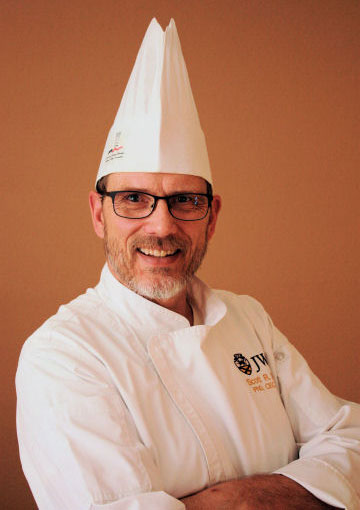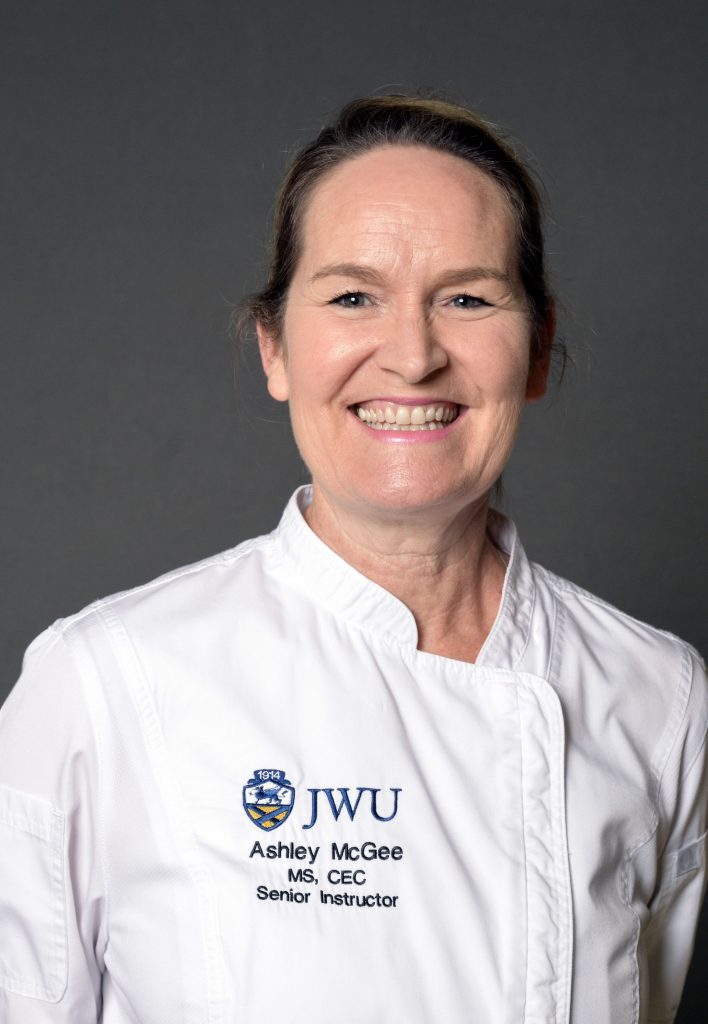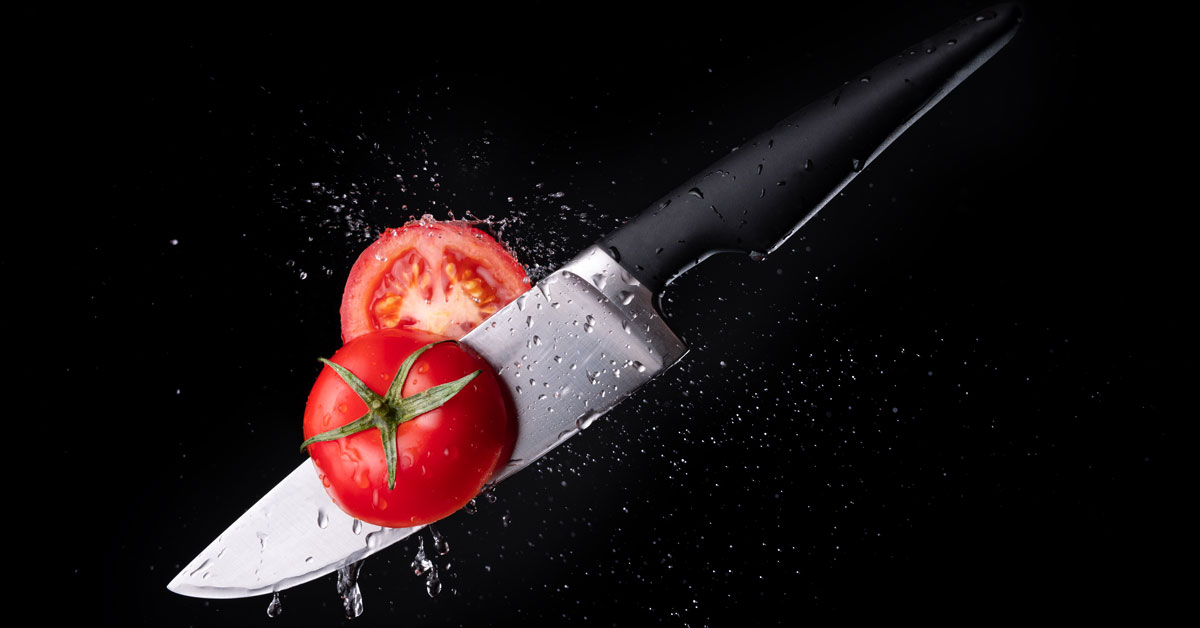With Scott Smith, Director of Online Culinary Programs &
Chef Ashley McGee, Senior Culinary Instructor

While delivery of the online laboratory courses in the Professional Culinary Skills Certificate program at JWU Online is through cutting-edge technology, learning culinary techniques always begins with the basic skills.
Scott Smith, Director of Online Culinary Programs for JWU Online explains, “As with learning any new skill, it takes good instruction, a lot of practice, and a good critique. This holds true for learning the basic knife cuts.”

This sentiment is echoed by Chef Ashley McGee, one of the chef instructors in the online culinary program and also on the JWU Charlotte campus.
“Knife cuts are the foundation for all cooking. Whether you are cooking professionally or at home, having excellent knife skills is, in my opinion, the most important tool that you can have in your toolbox as a cook and a chef. Mastering perfect knife skills showcases your expertise, helps your food cook evenly and visually makes the most impact upon making your food look incredible.”
Dice, julienne, bias, bâtonnet — How may knife cuts can you name?
Smith explains, “There are numerous knife cuts used in cooking, some with formal names, often using the French naming convention and some with interchangeable generic names. For example, the bâtonnet knife cut translates to and can be called a ‘small stick’ cut. The dimensions are ¼” x ¼” x 2” as compared to the julienne cut, which can be referred to as a ‘matchstick’ cut which measures 1/8” x 1/8” x 2”. These sticks can then cut into a diced cut, for example, using the bâtonnet cut to create a smaller sized dice cut. This cut is named macédoine or small dice which measures ¼” x ¼” x ¼”. In the CUL1010 Culinary Fundamentals course, student will learn and demonstrate the production of the 11 core knife cuts.”
Why use French names?
Smith qualifies, “Often knife cuts have French names due to the influence of French cuisine on the development of modern culinary techniques, particularly in western cooking. When it comes to cooking, there are terms used for cooking techniques, stations in the kitchen, and for the names applied to various classical knife cuts.
“Often, standardized terminology can be used to specify a set of guidelines, illustrate a process, or provide a precise size or measurement. Having this standardization benefits the cook in many ways, such as when reading a recipe, the cook will instantly know what size to cut a vegetable when the knife cut name is included with the ingredient description.”
Chef McGee adds, “It is important that the students know what the cuts are, how to properly hold and care for their knives and be able to perform the cuts with precision, accuracy, and efficiency. We work on precision and accuracy first. The efficiency comes with time and practice.”
The Professional Culinary Skills Certificate Program
How do online students learn knife cuts and other culinary techniques?
Culinary laboratory courses are delivered through a multimedia environment. In the first culinary lab course, CUL1010 Culinary Fundamentals I, students will learn how to do several basic knife cuts. Students watch videos of the chef instructors demonstrating the cooking methods and techniques, and film themselves using those same techniques to prepare breakfast, lunch, traditional and international dishes — all in the comfort of their home or other familiar kitchen. Chef instructors assess each student’s competencies and provide personalized feedback.
Chef McGee explains, “Teaching both on campus and in the JWU Online culinary program, I feel that by teaching in the online program, I can help to maintain the high standards of quality expected just as we uphold for the in-person student.”
Brooklyn Connell, ’23 comments, “I learned so much from the feedback I received from all the instructors. I would submit videos of myself, so they could observe my culinary techniques and see the food I prepared. Instructors would then record themselves talking about the assignments I submitted.”
“Evaluating the videos that students have submitted for their knife skills assignments,” Chef McGee mentions, “has its challenges in that sometimes I would love to jump into the video to help a student hold their knife in the proper manner or help straighten out a cut. Instead, I give each student valuable feedback and constructive criticism in order to help them improve while working at home.”
BĂTONNET KNIFE CUT INSTRUCTIONS
To help the student learn about how to do their knife cuts in the online classroom, here is a sample set of instructions from the CUL1010 Culinary Fundamentals I course on performing a bâtonnet cut.

Image from CUL1010 Culinary Fundamentals I Module 3 Lesson 2
Bâtonnet knife cut
In preparation of the knife cuts assignment or just for general cooking, here are tips when performing knife cuts:
- Start with a sharp knife.
- Use the right knife for the right job.
- Work in a clean area.
- Secure the cutting board so it does not move around.
- Grip the knife correctly when cutting.
- Properly hold the food being cut.
- Practice, Practice, Practice!
Interested in advancing your culinary career?
Johnson & Wales Online, in collaboration with JWU’s College of Food Innovation & Technology, is now enrolling for the Spring 2025 online Professional Culinary Skills Certificate program.
A worldwide leader in culinary education. JWU Online prepares graduates to advance their culinary career paths with skills and knowledge of food preparation through this 100% online certificate program. For more information about the PCSK program at Johnson & Wales Online, complete the Request Info form, call 855-JWU-1881, or email [email protected].
